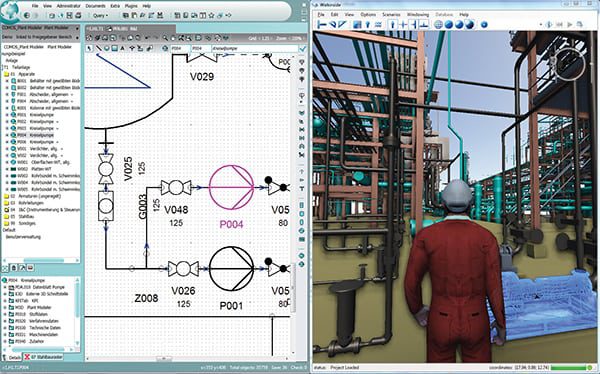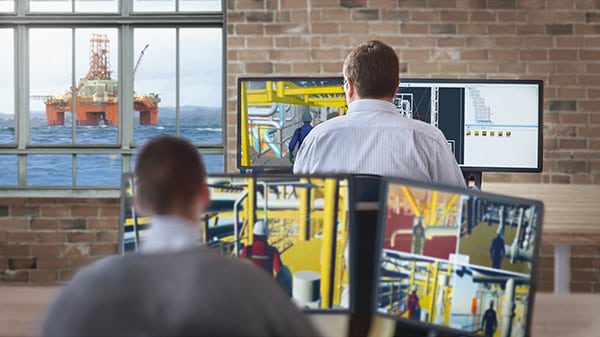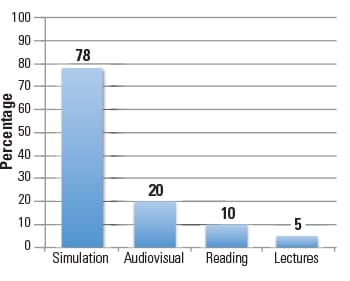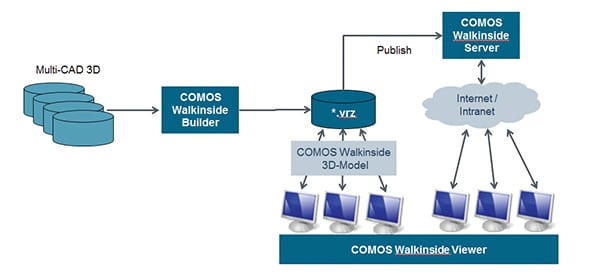Utilizing 3-D Virtual Reality Visualization for Efficient Power Projects and Training
It may look, feel, and sound like a video game, but 3-D virtual reality visualization software offers much more than fun. Power professionals are utilizing it for immersive operator training, engineering design review, plant operations and maintenance work, and crisis simulations.
The global power industry is becoming increasingly complex. Trends toward greater amounts of variable renewable energy are changing the requirements for conventional power plants. Energy market policies are increasing cost pressure. Infrastructure is growing outdated. Regulatory requirements are becoming stricter. Meanwhile, generators must continue efforts to more efficiently manage knowledge and information, while their personnel must be better trained in risk awareness.
New technologies are helping to address many of these issues. However, the industry trend toward technology-focused solutions requires preservation of the highest possible data quality and the optimization of legacy systems. That’s not always easy, because often, connectivity barriers between different systems and applications prevent effective communication between islands of responsibility. Upgrading interdisciplinary systems with more components and more intelligent technologies leads to larger amounts of, and more complex, plant data. That makes it important to enable integration between information technology platforms when redesigning related processes.
Expanding Data Needs
Making plant data available and manageable—any time and anywhere—in a consolidated system is one of the industry’s major challenges. Data handover from engineering to plant operations must improve in order to maintain efficient operations. Another challenge is that an increasing volume of data must be dealt with quickly, which leaves little time to assess critical situations. An additional consideration is the need to keep knowledge of all that data and the operations it represents within a company as the current workforce ages and retires.
Training is costly. Yet it is essential, because demands on staff continue to increase, and inexperienced personnel must be brought up to a certifiable level of proficiency to operate safely in potentially dangerous industrial facilities. These days, the new workforce also wants to access information and work more efficiently and intuitively.
One way to achieve those goals, and a requirement for effective plant management generally, is optimum networking and coordination of all disciplines and departments involved in the engineering and operation of a plant. One solution that can be used for the task is Siemens’ COMOS software. With its unified data platform, COMOS provides plant design engineers, plant operating personnel, company management, and solution partners with a continuous flow of data that meets their specific needs across all project phases and disciplines involved. COMOS acts as a global data hub for all aspects of asset information management and, thus, provides reliable plant and project documentation. The use of intelligent 3-D models enabled through COMOS Walkinside can make plant engineering and operation safer and more efficient.
Virtual Worlds
COMOS Walkinside is a powerful 3-D virtual reality (VR) visualization software solution that directly accesses all plant information to display the current status of a plant in visually appealing and realistic 3-D graphics. It does so by merging native files from diverse data sources and proprietary formats. COMOS Walkinside automatically reads information on geometry, computer-aided design (CAD) hierarchy, engineering database, and textures during the conversion process from the various CAD files, making initial 3-D model creation and subsequent updates easy, fast, and convenient (see sidebar).
| COMOS Walkinside at a GlanceThe COMOS Walkinside 3-D asset portal ensures a common understanding of a plant’s actual state for all project stakeholders. The system features:
■ Intelligent connection of geometrical virtual reality model objects with plant data. ■ Implementation of comprehensive engineering processes in 3-D through all plant lifecycle phases. ■ Bidirectional linking with document management systems, computerized maintenance management systems, and other plant-specific systems. ■ Visualization of real-time and historian distributed control system data. ■ Access to all relevant plant data for operation/maintenance. Benefits include: ■ Faster project execution, plant commissioning, and startup as a result of improved collaboration. ■ Cost savings through consistent and always-available asset information. ■ Fewer incidents and accidents. ■ Higher plant availability. ■ Safe and efficient plant operations. |
COMOS Walkinside enables the use of 3-D engineering data from the basic and detail engineering phases to the as-built phase during operations, providing completely transparent real-time asset information throughout the entire asset lifecycle. Highly complex process plant 3-D CAD models can be visualized immediately, while navigation is easy and game-like.
Using COMOS Walkinside as a 3-D asset portal enables all project stakeholders and decision-makers easy access to all plant information, thus ensuring a common and real-time understanding of a plant’s actual state. That is why the COMOS database and COMOS Walkinside training tool are so valuable. Whether used in conjunction or separately, they both provide in-context accessibility to 2-D and 3-D asset data about task-specific activities required by various personnel.
A Plant Lifecycle Solution
COMOS Walkinside facilitates project development, routine plant operation, and training throughout a plant’s lifecycle.
Project Development. During project development—whether new builds or retrofits—engineering, procurement, and construction (EPC) contractors must share their 3-D models with clients for regular design reviews. As COMOS Walkinside provides all stakeholders with a common and easy-to-use 3-D view of the actual project state, design reviews can be executed in early phases—spanning all disciplines. Process engineers, automation engineers, and other engineering disciplines—as well as management personnel, representatives responsible for safety at work, and maintenance managers—can all contribute to a higher level of project quality. Cost savings can be achieved through the avoidance of expensive changes during later construction and commissioning phases.
The software supports progress reviews, such as thorough integration of avatars (virtual characters) for virtual walkthroughs, redlining drawings, comments, and the creation of movies. Opportunities also exist for the integration of existing 2-D data, such as piping and instrumentation diagrams (P&IDs) or project documentation.
Plant Operation. By accessing actual plant data, operating personnel receive all required information in real time to make effective decisions. For example, they can quickly see where equipment is located and how they can best access it and retrieve related maintenance information. Based on that, maintenance activities can effectively be simulated, planned, and executed. Real-time information out of the distributed control system also can be visualized on demand. Real-time data and alarms are available and are represented in the 3-D model to ensure that actual information is available anytime and anywhere.
COMOS Walkinside also supports efficient remote plant operations. Experts do not necessarily have to be on site, because they can have access to data and documents from nearly anywhere in the world through the 3-D asset portal. This feature can save a lot of time, travel costs, and effort.
While cybersecurity for the 3-D model is the owner’s responsibility, access requires the correct software and hardware to visualize the 3-D model. The software and hardware must be obtained from Siemens and passes many controls to avoid it falling into unknown hands. Security is further enhanced using secure hypertext transfer protocol and virtual private networks. Training can be limited to local installations with no web-based access required. Human avatars, representing actual field operators, can be monitored in real time, thereby providing the opportunity to detect unapproved or suspicious activity.
Training for All Plant Stages and All Personnel. Even before construction of a plant, the COMOS Walkinside immersive training simulator (ITS) enables operators to dive into their future work environment. The experience allows commissioning times to be significantly reduced and ensures that key knowledge is retained and documented by the company.
The instructor, a subject-matter expert from the operations department staff or a qualified third-party service provider, can deliver standard operating procedures (SOPs) to trainees as scripted, in-context scenarios in the form of tutorials or step-by-step guided work sequences to test compliance and operator performance, thereby leading to certification. Instructors can create the content of all training lessons by interactively importing SOPs from maintenance documentation manuals, using an intuitive scenario editor, while trainees can configure their own individual avatars.
Training several people in parallel using the same 3-D model not only improves team-building and collaboration, but it also allows lessons learned to be communicated more easily between important stakeholders, such as within a group of control room personnel or among maintenance crew members.
This virtual training can be used for familiarization with the basic plant environment (such as locations of valves, piping, and equipment) and can be deepened by practice of SOPs (Figure 1). Operating behavior and composure during unscheduled events such as fire, gas leaks, or accidents can be tested with the ITS and the desired actions taught through specific exercises (Figure 2). Optimally trained personnel help to substantially minimize the risks of incidents or unplanned shutdowns.
 |
| 1. Virtual world. 3-D models and diagrams help familiarize personnel with equipment locations. Courtesy: Siemens COMOS Industry Solutions |
 |
| 2. An immersive training experience. Lessons can be customized and tailored to meet individual student needs. Courtesy: Siemens COMOS Industry Solutions |
Value Propositions for VR Training
Conventional classroom formats remain the norm for internal and external training, but creative and more-motivating approaches are rapidly emerging. They include leveraging the EPC’s CAD models and plant laser-scanning data to present to users a 3-D VR simulation of the work environment that can be navigated simply and rapidly, as if in a video game.
The rules of engagement with COMOS Walkinside can be customized as the model is presented so that trainees are not just exposed to generic training but, rather, to a high-fidelity replication of their actual plant, with its texture, color, and even 3-D stereo sounds emitted by rotating equipment and pumps. Such details are far more than a gimmick, particularly when simulating emergency situations, where trainees are tested and graded on their capacity to find and follow egress routes and report to muster locations in preset time limits.
Under simulated smoke and fire with computational fluid dynamics, an accurate overlay on the 3-D model of smoke dispersion patterns under variable wind directions provides unique experiences where sound cues from rotating equipment can help direct operators to safety when their visibility is impaired. The memory of having been in a particular déjà vu situation before is a powerful experience that cannot be realized in conventional training environments, where it is difficult to increase stress levels, such as by surrounding the field operator with smoke, playing loud alarms, showing a dangerous spill on the floor, or presenting a “man-down” situation—where reflexes may stand in the way of implementing preestablished procedures. The exercise can potentially mean the difference between life and death during an emergency.
Stress jolts memory and boosts retention rate during training. Hence, it is easy to understand why a photo-realistic environment can deliver much higher retention rates than conventional training; some studies suggest that students remember no more than 6% to 10% of their training material after six months when reading and lectures are the training mode (Figure 3).
 |
| 3. Learning retention rates. Simulation is the clear winner among these familiar training modes when it comes to retention. Source: NTL Institute for Applied Behavioral Science |
In addition, for each rehearsed procedure, access to information about plant equipment in the COMOS database can be generated from the 3-D VR model, such as maintenance history, equipment manufacturer’s specifications, and recommended maintenance or replacement procedures. The position of the equipment in the P&ID, engineering instruction and control schematics, and process flow diagrams helps the operator, teammates, and supervisor share the same information about mission-critical procedures, such as lockout/tagout of subsystems and bypass of sensitive portions of the plant. (To view a video of the 3-D visualization system, go to: bit.ly/1ve7TlQ.)
The system faithfully and realistically represents the actual plant and its associated information, which boosts productivity and efficiency while minimizing plant downtime. Customers benefit from optimized project execution, commissioning, and startup, and improved asset availability compared to conventional approaches.
In-context training is the “name of the game” (pun intended) when it comes to interactive training, as scenario-driven sequences of all work orders can be assigned to targeted trainees for guided tutorials, freehand rehearsals, or testing of their ability and performance. Unscripted events can also be interjected at will by the instructor in the students’ standard procedure training to test trainees’ behavior and composure under stress, similar to the way airline pilots are evaluated before, during, and after qualifying on a new aircraft. The process develops greater composure under stress, improving reactivity and safety for individual operators, their teammates, and their working environment.
Easy Configuration and Effective Results
Although one might think that such a sophisticated setup would require an expensive or complex hardware environment, 3-D visualization workstations or laptops are often sufficient to power up the simulated world. COMOS Walkinside is easy to deploy and use, and is immediately available for trainees to begin immersive learning activities. More-powerful configurations can be designed to meet more-advanced requirements, including instructor consoles, remote training stations, 3-D active stereo, high-resolution screens, head-mounted devices, Kinect or other motion-sensing technologies, and more.
The 3-D VR model can be created automatically within a few hours and requires little customer effort (Figure 4). Changes to the 3-D CAD master data are reflected very quickly in the 3-D VR model. In addition, the system is capable of handling massive 3-D CAD files.
 |
| 4. The workflow process. Creating and publishing 3-D virtual reality models is quick and easy. Courtesy: Siemens COMOS Industry Solutions |
TOTAL Exploration and Production (E&P) offers one example of a successful installation. The company uses the COMOS Walkinside solution to train operators for its floating production storage and offloading vessels. In one survey, 92% of the students who used the system evaluated the training as very useful and interesting.
“If you participate in ITS, you have less loss of production due to human error; we minimize the loss of production,” said Nicolas Tarisse, field operations training manager at TOTAL E&P. As a result, the company believes it is able to increase efficiency, improve safety, lower risk, and increase asset uptime, which enhances its return on investment.
More Innovations Ahead
As many of our technology users complete their first projects and have the opportunity to evaluate the system, management endorsement for the immersive approach grows. Statistics on training performance and tangible benefits are being developed. As positive feedback increases, acceleration of enterprisewide deployment of the technology is being witnessed.
Innovation continues with a new wave of even more creative implementations, including vibratory ground motion simulations, more-dynamic rendering engines with reflective and diffracted ray beams, smell generation, and synthetic real-time metering of simulated radiation accrual or toxic exposure. Actual work permits can be associated with scripted workflow sequences. Execution times and exclusion zones can be simulated, in which unauthorized personnel trigger alarms if they stray from their assigned work responsibilities. The possibilities are limited only by the imagination. ■
— Manuel Keldenich ([email protected]) is product marketing manager for COMOS Plant Engineering Software at Siemens.